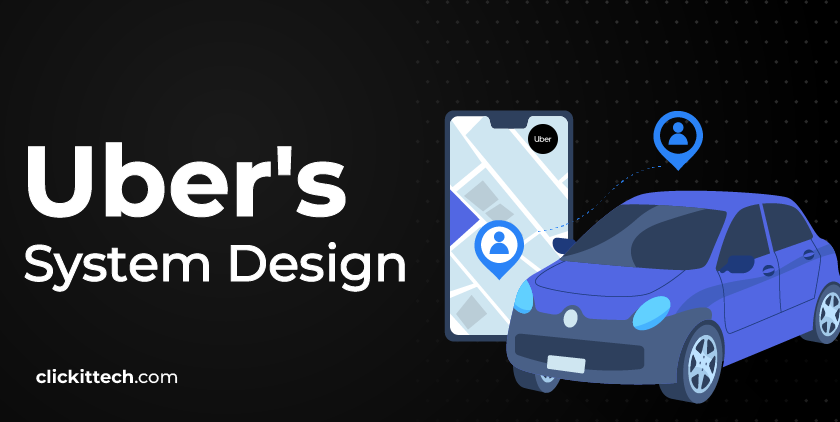Uber’s innovative platform is meticulously crafted with the intricate Uber System Design.
Uber was born out of Travis Kalanick and Garrett Camp’s inability to get a ride in Paris in December 2008. By March 2009, they had an app ready, letting people hail rides with a tap. Uber expanded internationally in December 2011, with its launch in Paris.
Uber has transformed transportation and encouraged several entrepreneurs to reevaluate established markets. It is now recognized as a symbol of innovation. And behind all this is an amazing Uber System Design, which we will uncover next!
- The Requirements for System Design Uber
- System Design Uber: Technology Stack Overview
- Uber’s Architectural Paradigm: From Monolith to Domain-Oriented Microservices
- Evolution of Uber’s Big Data Platform
- Optimizing Database Performance with CacheFront
- Data Security in System Design Uber
- Harnessing Rider Data for Business Insights in the Uber Ecosystem
- The Evolution of Uber’s Chat Channel
- Conclusion of System Design Uber
- System Design Uber FAQs
The Requirements for System Design Uber
Uber System Design provides insightful information about how effectively serves its large user base, ensuring a seamless experience for millions of drivers and riders globally.
Beyond transportation, other sectors can also learn a lot from Uber Design approach. Businesses can enhance their platforms’ scalability, reliability, and performance by adopting the Uber System Design approach. Uber design provides a model for creating and refining complex systems across multiple sectors. Moreover, it demonstrates the ongoing innovation driving the advancement of urban mobility.
System design is an essential step in creating sophisticated software and technology architecture. The architecture and functions of the system are shaped by these fundamental criteria, which serve as the building blocks. However, what precisely are these requirements for system design, and why are they so important? Let’s examine them now.
Functional Requirements:
The features, capabilities, and functions that the system must have are outlined in the functional requirements as follows:
- Account Creation:
Giving the required information for registration should be a simple process for users to create accounts. - User Login:
Authentication credentials should allow registered users to safely access their accounts. - Real-time Ride Matching:
Users should be able to easily connect in real-time with nearby drivers who are available for rides. This would enable quick ride requests and effective pickups depending on variables like location, vehicle type, and driver availability. - Secure Payment Processing:
With strong encryption methods and safe payment gateways, users should be able to complete financial transactions quickly and safely. - Geolocation Services:
The platform should use GPS technology to precisely track user positions, design the best routes, and provide real-time updates on ride progress to improve overall user experience and enable smooth communication between drivers and riders.
Non Functional Requirement:
Non-functional requirements ensure the system meets specific quality standards and define how it operates in various scenarios. Performance, scalability, security, reliability, and compliance are some of the topics they address. Non-Functional requirements for a ride-hailing service like Uber may be as follows:
- Performance Requirements:
To maintain smooth operation during periods of high demand, the system must maintain minimum latency and maximize throughput. - Security Requirements:
To protect user data and stop illegal access, robust authentication and encryption procedures must be put in place. - Compliance Requirements:
To protect user data and guarantee privacy compliance, the platform must abide by the regulations outlined in the Data Protection Regulations. - Scalability Requirements:
To support growing user traffic while preserving performance levels, the infrastructure must be scalable. - Dependability and Accessibility Requirements:
To ensure continuous service delivery and high user uptime, the system must include failover solutions.
Improving Rider-Driver Communication and Experience
If you use Uber frequently, you’ve probably run into scenarios when the driver calls to ask where you’re going. This is a common occurrence that detracts from the seamless experience that the platform promises. Such disruptions, coupled with extended arrival times, can be inconvenient for drivers and riders both.
Uber has launched a number of attempts to solve these issues after realizing that they must continue to deliver on their promise to provide flawless service.
- First, to remove the need for these questions and minimize confusion, they are testing the idea of giving drivers trip destinations prior to acceptance.
- Uber is also experimenting with new incentive schemes to recognize and reward drivers who go above and beyond, especially those who make longer trips to pick up passengers.
- Additionally, they actively interact with drivers to stress the value of reducing cancellations of accepted trips and providing rewards to encourage adherence to service quality requirements.
Uber is committed to rapidly resolving unforeseen events, even though they occasionally arise. This ensures that riders continually receive a high-quality service.
System Design Uber: Technology Stack Overview
Infrastructure Provisioning
Uber uses tools like Terraform for Infrastructure as Code (IaC) management as part of a highly automated infrastructure provisioning process.
With Terraform, engineers can write code to describe infrastructure settings, which makes it possible to provision resources consistently and repeatedly across many environments. Time-to-market for new features and updates is accelerated, human error reduction is achieved, and the deployment process is streamlined by this automation.
Building Container Images
A key component of Uber’s microservices architecture that supports its continuous deployment approach is the creation of container images. Uber’s primary platform for building container images is called uBuild, which was first released in 2015 and has since undergone modernization.
By abstracting away infrastructure complexity, it gives developers a consistent interface through which to create container images that are compliant and optimized. uBuild simplifies development workflows and guarantees consistency across services by centralizing the build process.
Web Application Stack
Node.js is used for server-side logic, React.js is used for dynamic UI rendering, and GraphQL is used for effective data fetching in the development of Uber’s web applications. With its dynamic maps and geolocation capabilities, Mapbox improves user experience by offering mapping and location services.
Mobile Application Stack
Swift, Java, and React Native are used to create Uber’s native mobile applications for the iOS and Android operating systems. State management is handled by Redux, while data interfaces with backend services are facilitated via GraphQL. Real-time navigation and location monitoring are made possible by Mapbox integration.
Data Management and Storage
Uber uses a wide range of databases suited to different purposes to manage its enormous data environment. Large amounts of data can be stored offline using the Hadoop Distributed File System (HDFS), while online transactions can be facilitated by MySQL’s relational database structure. Cassandra is a distributed NoSQL solution that is perfect for real-time applications, whereas Schemaless gives flexibility for storing unstructured and semi-structured data.
Uber uses DocStore, a powerful SQL database built for heavy workloads internally, and Redis as a distributed caching solution. Uber also makes use of public cloud storage options from companies like AWS, Google Cloud, and Azure to provide scalable and dependable infrastructure for storage. Hive is a data warehousing system that makes it possible to efficiently query and analyze large databases within the organization.
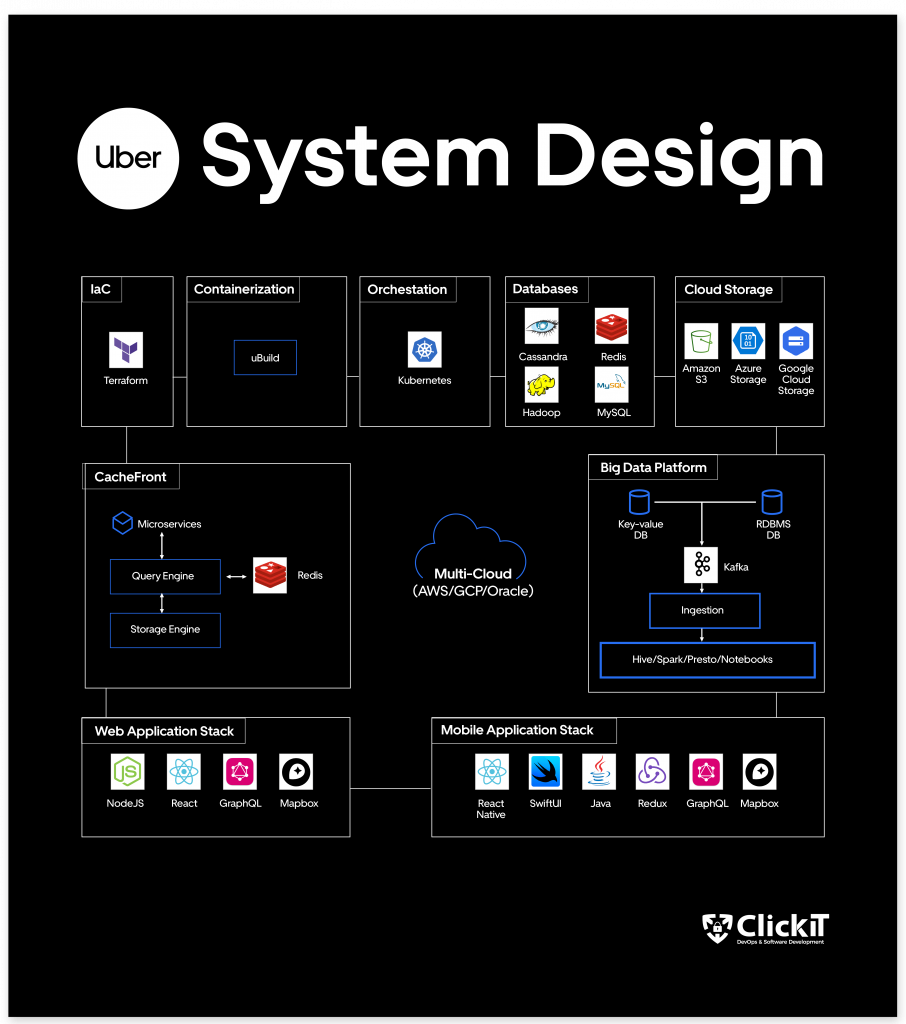
These are only a handful of the many technologies that Uber uses. Uber engineers use a combination of state-of-the-art tools and platforms to innovate continuously to guarantee the performance, scalability, and dependability of their services.
Need assistance to integrate top-notch in your SaaS application? Book a Free call with our team!
Uber’s Architectural Paradigm: From Monolith to Domain-Oriented Microservices
Inception of Microservices: Solving Monolithic Constraints
Considering Uber’s modest beginnings, a monolithic design was adequate for its first attempt to enter the ride-hailing industry. Within the framework of Uber Design, this monolith fulfilled its objective of enabling payment processing and driver-rider matching with a single product and a restricted presence in San Francisco. However, as Uber’s goals increased and its reach grew throughout the world, it became evident that this monolithic strategy had its limitations.
Transition to Microservices: Embracing Flexibility Amidst Complexity
Uber made the crucial choice to switch to a microservice architecture when faced with the difficulties of maintaining a monolithic codebase despite fast development. Operational advantages, including autonomous deployments, more distinct ownership, and improved system stability, were promised by this change.
However, as Uber’s ecosystem grew to include thousands of microservices, additional complications appeared and threatened to negate the very benefits that microservices were supposed to bring.
Challenges of Conventional Microservices: Navigating Complexity
Numerous difficulties, such as difficulties with dependency management, higher overhead associated with cooperation, and increased system instability, were brought about by the widespread use of microservices. Uber discovered that the complex web of relationships between services was preventing engineering teams from being as creative and agile as they might be. It became clear that a more organized and controllable approach to microservices was required.
Enter Domain-Oriented Microservice Architecture (DOMA): A Paradigm Shift
Uber developers set out on a revolutionary quest to improve their architectural paradigm in reaction to the growing complexity of traditional microservices. The end result was the development of the innovative Domain-Oriented Microservice Architecture (DOMA), which aimed to reduce complexity while maintaining the operational advantages of microservices. DOMA marked the beginning of a new phase in Uber’s architectural development by drawing influence from well-established design principles and creative tactics.
Key Principles of DOMA: Structuring Complexity for Agility
A number of fundamental ideas were presented by DOMA with the goal of organizing microservices into coherent, controllable units:
- Domain-Centric Approach:
Logically grouping microservices into domains, allowing for the separation of functionalities and ownership. - Layered Design:
Using layered structures to manage dependencies and reduce blast radius in the event of a breakdown is known as layered design. - Gateway Abstraction:
By introducing gateways as solitary points of access into domain collections, internal intricacies are abstracted away, making future migrations easier. - Extension Mechanisms:
Increasing flexibility and scalability by offering ways to expand domain functionalities without sacrificing core implementations.
Impact and Adoption of DOMA: Empowering Innovation
For Uber, the adoption of DOMA produced important advantages for the platform and product teams:
- Enhanced Developer Experience:
Optimizing development procedures, cutting down on overhead associated with cooperation, and quickening the release of new features. - Decreased System Complexity:
Maintainability and extensibility are improved by grouping microservices into coherent domains. - Ease of Future Migrations:
Ensuring system stability, minimizing the effects of service churn, and facilitating smooth migrations and updates. - Empowered Product Innovation:
Promoting agility and flexibility in a changing market by enabling quick innovation and experimentation.
Looking Ahead: The Continued Evolution of Uber’s Architecture
As Uber keeps changing its architectural model, DOMA is evidence of the company’s dedication to creativity and flexibility within the realm of Uber Design; it continues to be at the forefront of architectural excellence, strongly negotiating the complexity of modern software engineering while keeping a close eye on scalability, stability, and developer experience.
Evolution of Uber’s Big Data Platform
Uber’s Big Data platform has experienced a remarkable transformation in the rapidly evolving technology industry to keep up with the company’s exponential expansion and shifting business needs. Let’s explore the evolution of Uber’s Big Data platform over its many generations, emphasizing the significant turning points, difficulties, and creative solutions that have influenced it.
Generation 1: Building the Foundation
Traditional relational databases provided the foundation for Uber’s early Big Data venture and its data architecture. An essential part of Uber’s initial iteration of the Big Data platform was data processing and storage, which was handled by MySQL and PostgreSQL. These databases offered a strong basis for organizing structured data, but they quickly showed to be insufficient for managing the massive amounts of data produced by Uber’s quickly growing business.
Generation 2: Embracing Hadoop
It strategically changed its second generation of Big Data infrastructure to focus on the Hadoop ecosystem after realizing the need for a more adaptable and scalable solution. The main storage engine of this transition was the Hadoop Distributed File System (HDFS), which was backed by Apache Spark for data processing, Apache Hive for data warehousing, and Presto for interactive querying.
With this change, Uber was able to get above the constraints of conventional databases and adopt a horizontally scalable architecture that can manage enormous volumes of data.
Generation 3: Rebuilding for the Long Term
This app kept using Hadoop in its third iteration of its Big Data platform, but it also included new technologies to improve data processing and storage even further. Hadoop remained the cornerstone, but with the release of Hudi (Hadoop Upserts Deletes and Incrementals), data management achieved a major turning point by enabling incremental updates and cutting down on data latency. Improvements in data modeling and standardization also contributed to the platform’s increased efficiency and streamlined operations.
Generation 4: Looking Towards the Future
Uber’s fourth iteration of its Big Data platform is ready to take advantage of a wide range of databases and technologies to promote efficiency and creativity as it looks to the future, investigating new options like real-time databases, NoSQL databases, and cloud-based solutions to address the changing needs of its data-driven ecosystem, even if Hadoop will always play a major role. It hopes to open up new options for scalability, dependability, and real-time insights by adopting a hybrid approach to database management.
The Big Data of the Uber platform’s development from the early days of relational databases to the era of distributed computing and cloud-native solutions is a reflection of larger developments in database technology.
Within the framework of Uber Design, Uber remains ahead of the curve and use data to push commercial success by embracing the appropriate combination of databases and technology at every turn in its path. Uber’s database journey will have a significant impact on how transportation and other industries develop in the future as it innovates and expands.
Optimizing Database Performance with CacheFront
Uber’s distributed database, Docstore, processes tens of millions of queries per second and stores enormous amounts of data. It is essential to the company’s numerous microservices. However, Uber encountered difficulties guaranteeing scalability and low latency access as demands rose and complexity increased.
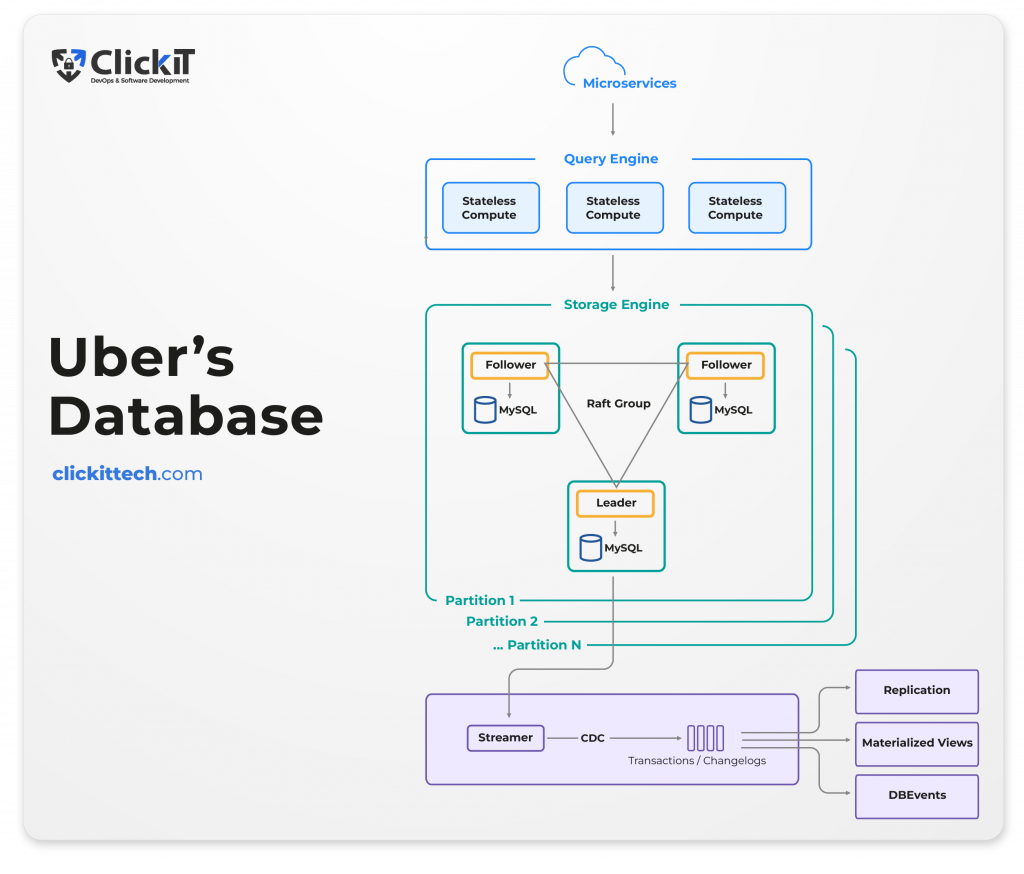
Despite Docstore’s resilience, a number of issues surfaced as demand increased. Conventional approaches to scaling, whether horizontal or vertical, have proven inadequate to handle the increasing demands of the workload. Furthermore, latency problems were made worse by the difference in read and write requests, which called for a more creative caching strategy.
CacheFront Architecture:
CacheFront was designed to minimize the need for significant scalability to improve latency and cut expenses. It guarantees smooth operation and scalability by implementing caching directly into the query engine layer of Docstore. Cache invalidation, adjustable timeouts, and circuit breakers are all included in the design to improve efficiency and reliability.
The architecture of CacheFront incorporates cutting-edge approaches to address challenging caching problems. It uses techniques like adaptive timeouts, negative caching, and cache warming in conjunction with Redis as a distributed caching solution to maximize performance and consistency.
Uber has a 99.9% cache hit rate thanks to CacheFront, which eases the load on the storage engine while handling over 40 million requests per second. This achievement has simplified infrastructure management and improved performance, freeing developers to concentrate on innovation rather than upkeep.
CacheFront will continue to be a vital component of Uber’s infrastructure as it develops, allowing the business to provide flawless experiences to millions of users across the globe.
Data Security in System Design Uber
Uber prioritizes protecting user data, and implementing strong data security procedures is essential to upholding the integrity and confidence of the services offered. Within the framework of Uber System Design, the company uses fine-grained encryption, a complex method that improves access control, retention policies, and encryption at rest, as the cornerstone of its data security policy.
Fine-Grained Access Control
Giving users granular access to data is the foundation of Uber’s data security model. Conventional access control systems frequently limit access to whole tables or databases by functioning at a coarse-grained level. Uber is aware of the necessity for more sophisticated control, though, particularly in a setting with a variety of dynamic data sources.
Uber allows data owners to define access rights down to the column level by implementing fine-grained access control. This helps to protect confidential data while facilitating authorized data usage. Uber uses the features of Apache Parquet to enforce access limits based on preset tags, giving data owners the flexibility to create access policies that meet their unique needs.
Encryption at Rest
Uber’s data security approach is based on data encryption, which adds an additional layer of protection against unauthorized access. The company uses Apache Parquet to implement column-level encryption, going beyond conventional techniques.
This method maximizes security while minimizing performance overhead by encrypting individual data fields rather than the full information. Uber guarantees data security and integrity even in the case of unauthorized access or data breaches by utilizing encryption methods like AES-GCM and AES-CTR.
Data Retention Policies
For the purpose of managing the data lifecycle and regulatory requirements, effective data retention rules are essential. Uber understands the need for adaptable retention policies that meet changing business and legal requirements. It also applies column-specific retention policies, enabling the selective removal of data according to pre-established categories or tags by utilizing Apache Parquet modular encryption, which can meet retention standards with this strategy while reducing data loss and storage expenses.
Enhancing Account Security: Uber’s Tips and Recommendations
Furthermore, Uber offers crucial guidelines to improve user account security. To ensure security against potential unauthorized access, users are advised to change their passwords frequently. For smooth verification procedures, it is crucial to maintain current personal information, including phone numbers and email addresses.
Users are also recommended to proceed with caution and adhere to fundamental security protocols, which include not disclosing login credentials, double-checking emails received from Uber, and creating distinct passwords for every account. Users can reduce security risks and have a safer experience on the platform by following these suggestions.
Harnessing Rider Data for Business Insights in the Uber Ecosystem
Data is the lifeblood of the dynamic ridesharing industry, enabling improved consumer experiences, operational efficiency, and strategic decision-making. Within the Uber ecosystem, rider data is essential to developing the Uber Rider App, which is always changing to accommodate the ever-changing needs of millions of users globally.
Rider Data and Its Significance
The Uber Rider App is essentially a treasure mine of rider data that includes every contact, choice, and trip that users have taken. The basis for improving important app features like funnel conversion, user engagement, personalization, and efficient communication tactics is this enormous data pool. Uber can discover pain areas, understand user behavior trends, and create tailored solutions that increase user satisfaction and loyalty by utilizing rider data analytics.
Standardizing Logs for Consistency and Efficiency
The data journey starts with careful online data collection, whereby mobile event logging is used to record user interactions with the Uber Rider App in real-time. Strict guidelines are followed in this procedure to guarantee log standardization, platform consistency, respect for user privacy settings, and network utilization optimization without sacrificing user experience.
The standardized logs are essential documents that offer insights into the preferences and behavior of users across the app’s several touchpoints.
Backend Event Logging and Offline Data Processing
Backend event logging is essential for tracking the content that users see within the application and recording user interactions. When used in conjunction with offline data processing, this backend logging technique makes it easier to organize and model raw data into insights that can be used. Uber can identify issue areas and analyze the impact of solutions by gaining greater insights into user behavior through the enrichment and modeling of offline statistics.
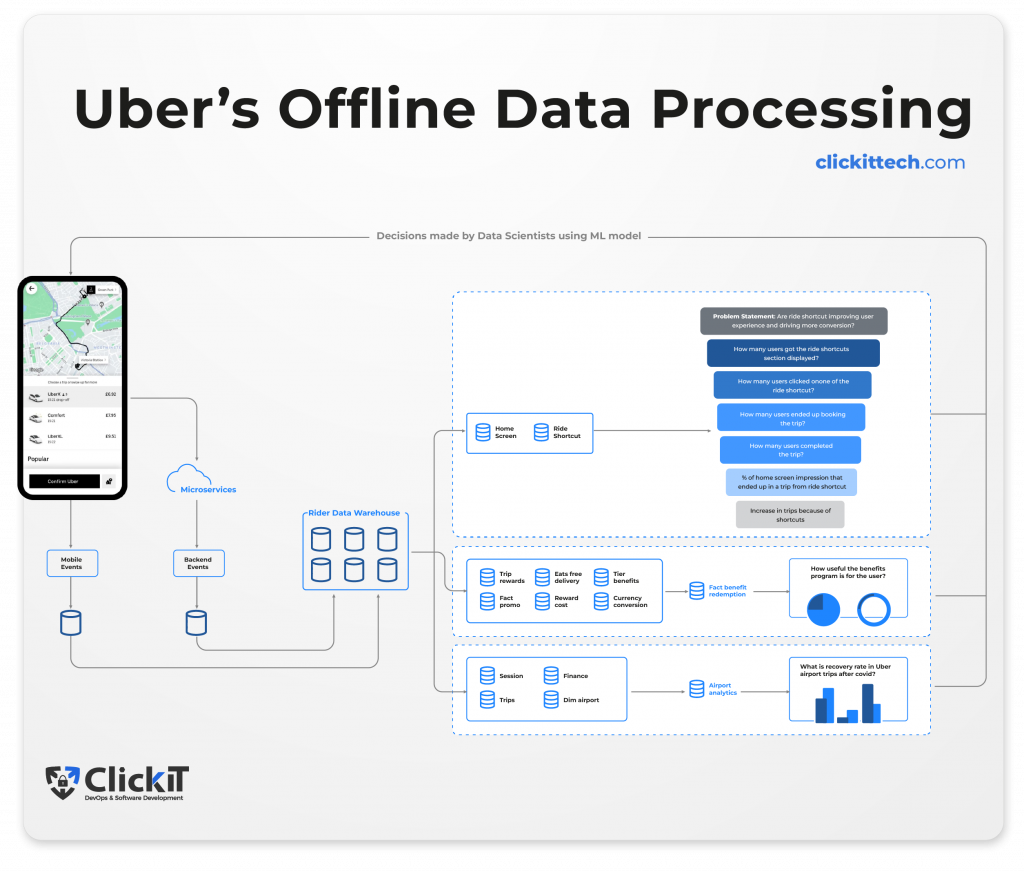
Driving Business Insights through Data Analytics
The result of these efforts is the production of useful business insights that influence strategic choices made by the Uber ecosystem. Data analytics is a potent tool for identifying possibilities and resolving issues, whether it is analyzing the effects of ride shortcuts on user experience, determining the efficacy of rewards programs, or determining the recovery rates in airport journeys following COVID-19. Uber can estimate demand, predict future trends, and proactively modify its services to meet changing user needs thanks to predictive analytics.
In simple terms, data analytics is the engine that accelerates innovation and optimization in the Uber Rider App, influencing the direction of ridesharing and urban mobility in the future. Uber can provide individualized experiences, increase operational efficiency, and maintain its leadership position in a constantly changing market by utilizing rider data.
Uber’s data analytics division will continue to lead the way in providing millions of riders globally with a smooth and connected transportation experience as it grows its global presence and improves its offerings.
The Evolution of Uber’s Chat Channel
Uber’s success is dependent on both its sophisticated transportation solutions and its strong technological foundation, which includes its customer service systems. Among these, Uber’s chat channel evolution is particularly noteworthy as evidence of the company’s dedication to operational efficiency and excellence in user experience within the Uber System Design.
Evolutionary Phases:
- Foundation:
The foundation for effective customer communication was established by the chat channel’s creation, which complemented more conventional help channels like phone and in-app messages. Simple WebSocket protocols for real-time messaging were among the early technologies. - Adaptation:
Uber adapted by using distributed computing technology, which allowed for scalability and agility in response to increased client questions. Technology like the distributed streaming platform Apache Kafka made it easier for customer agents and backend systems to communicate with each other. - Optimization:
The effectiveness and dependability of the chat channel were completely transformed by innovations like GraphQL subscriptions. An API query language called GraphQL made it possible to retrieve data quickly, lowering latency and improving user experience in general. Stateless microservices designs have also increased system scalability and maintenance. - Future-Forward:
In order to improve scalability and responsiveness even more, Uber is investigating hybrid architectures and real-time databases. Uber can now store and retrieve massive amounts of customer data in real-time, guaranteeing quick response times and individualized client experiences, thanks to technologies like the distributed NoSQL database Apache Cassandra.
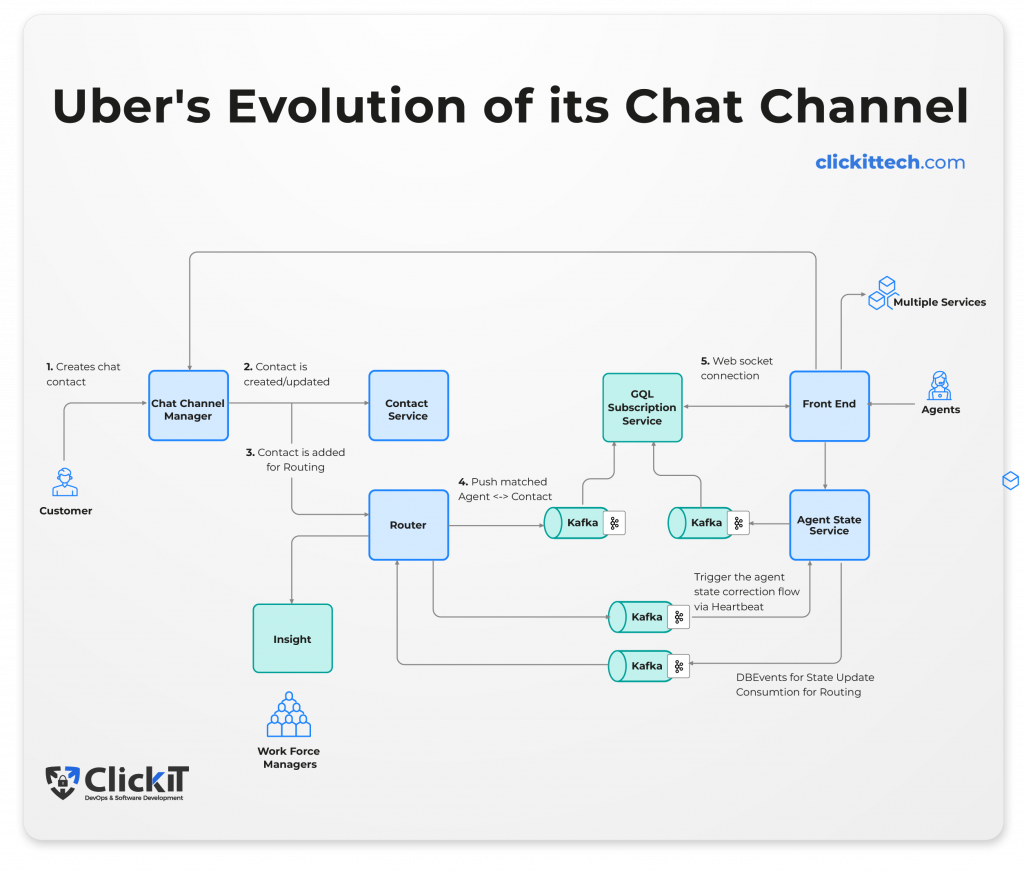
Uber’s evolution of its chat channel is a prime example of its dedication to innovation and top-notch customer support. Uber keeps setting new benchmarks for customer service in the digital age by utilizing state-of-the-art technology and best-in-class practices.
You can also read our blog about Netflix architecture.
Conclusion of System Design Uber
Uber System Design is an incredible achievement in engineering and innovation that allows one of the biggest and most significant ride-hailing systems in the world to run smoothly.
Uber has used various tools and technologies to optimize its system design, boost performance, and improve the user experience during its development.
It has adopted automation and modern development techniques like Terraform and containerization with uBuild to optimize operations and shorten the time to market for new features.
Uber’s adoption of cutting-edge technologies such as Node.js, React.js, GraphQL, and Mapbox for its online and mobile application stacks, coupled with its robust infrastructure, ensures a seamless and user-friendly experience across platforms. The integration of sophisticated analytics tools with big data platforms like Hadoop and Apache Spark has allowed Uber to glean valuable insights from its vast data environment, facilitating strategic planning and informed decision-making.
Uber has demonstrated its commitment to staying at the forefront of technological innovation by expanding its big data platform, using advanced optimization algorithms, and shifting from monolithic to domain-oriented microservices architecture.

System Design Uber FAQs
Uber changed its architecture from monolithic to Domain-Oriented Microservices Architecture (DOMA) to overcome the challenges of maintaining a monolithic codebase and gain advantages in terms of operational stability, autonomous deployments, and clearer service ownership.
Uber System Design discusses the fundamental technology stack and architecture driving Uber’s ride-hailing business. It is essential to comprehend because it provides information on how Uber effectively services its vast user base, guaranteeing a flawless experience for millions of drivers and riders worldwide.
It also serves as a model for developing and improving complex systems involving several industries and presents the latest advancements in urban mobility technology.

